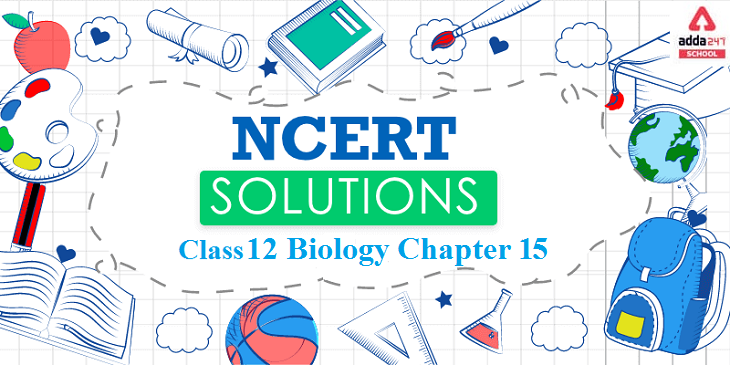NCERT Solutions For Class 12 Biology Chapter 15 pdf download
Adda 247 provides NCERT Solutions for Class 12 Biology chapter 15 NCERT solutions which is for the students who want to go ahead in life and achieve great marks in their examinations. The NCERT Solutions for class 12 are provided by the teachers who are experts of their subjects. The solutions are set according to the rules formulated by the NCERT class 12 biology and in the language that can be understood by every student. By these reading the solutions students can build up a strong base easily. The NCERT class 12 Biology solutions covers the chapters 1 to 16 with the important questions and the answers in a detailed way.
Examinations can be threatening for some people, a proper learning of the concepts is the key to crack the examination. Students rely on the solutions of the NCERT provided by Adda 247. The solutions are formulated by the experts of the subjects who have tremendous knowledge in their subjects.
These NCERT Solutions of class 12 chapter 15 help the students to get familiarized with the textbooks. The students can access the solutions anywhere while browsing the web easily. The solutions are very precise and accurate.
NCERT Solutions for Class 12 Biology Chapter 15– Biodiversity and conservation
The chapter provides information about Biodiversity and conservation. Biodiversity can be studied at Genetic diversity, Species diversity, Ecological/Ecosystem diversity. Greater the genetic diversity among organisms of a species, more sustenance it has against environmental perturbations. Genetically uniform populations are highly prone to disease harsh environment. Species richness: It refers to the number of species per unit area. Ecological Diversity is related to species diversity.
Features of the NCERT Solutions for Class 12 Biology Chapter 15– Biodiversity and conservation
NCERT Solutions for class 12 biology chapter 15 have been answered based on the important information on the question.
- The columns are used wherever necessary.
- Solutions are solved point wise and accurately answered point to point.
Important Question of Ncert Solutions for class 12 biology chapter 15: Biodiversity and Conservation
Question 1. Name the three important components of biodiversity.
Answer: Biodiversity is the various types of organisms in the ecosystem. Genetic diversity, species diversity and ecosystem diversity are three important components of biodiversity. Genetic diversity takes into account the genetic variations present in a species whereas ecosystem diversity refers to types of ecosystem present on earth. Species diversity refers to species richness.
Question 2. How do ecologists estimate the total number of species present in the world?
Answer: The diversity of living organisms present on the Earth is very vast. According to an estimate by researchers, it is about seven millions.
The total number of species present in the world is calculated by ecologists by statistical comparison between a species richness of a well-studied group of insects of temperate and tropical regions. Then, these ratios are extrapolated with other groups of plants and animals to calculate the total species richness present on the Earth.
Question 3. Give three hypotheses for explaining why tropics show the greatest levels of species richness.
Answer: In tropics:-
No Catastrophes – In tropics, there has been no catastrophes but is temperate areas glaciations and other catastrophes have caused large scale of destruction.
Non-seasonal Environment – In tropics, seasons are nearly uniform. It promotes rich and increases species diversity.
Solar Energy – Tropics get lots of sunlight which enhances productivity.
Question 4. What is the significance of the slope of regression in a species-area relationship?
Answer: The slope of regression has a major role in determining the species-area relationship. In smaller areas slope of regression is similar regardless of the taxonomic group or region. On the other hands, in case of larger areas, curve us steeper. Biodiversity also increases from higher to lower altitudes.
Question 5. What are the major causes of species losses in a geographical region?
Answer: There are four major causes that can lead to species loss in an area.
- Habitat loss and fragmentation: Changes caused in a habitat due to uncontrolled and unsustainable human activities such as deforestation, slash and burn agriculture, mining, and urbanization can result into breaking up of the habitat into small pieces, which effects various species and the movement of migratory animals. This leads to decrease in the genetic exchange between populations leading to decreased population of species. It is the most important cause leading to species extinction.
- Over-exploitation: Human greed has led to over-exploitation of various natural resources which has led to endangering and extinction of various species over years.
- Alien species Invasions: Alien species that the introduced unintentionally or deliberately can become invasive and can cause declination or extinction of indigenous species.
- Co-extinctions: Various species can be connected to each other in an obligatory way. When one species gets extinct, other plants or animal species associated with it also gets extinct.
Question 6. How is biodiversity important for ecosystem functioning?
Answer: Ecosystems consist of groups of organisms interacting with their abiotic environment, and they perform many functions that are critical for maintaining the conditions that allow for life to occur. Plants and other autotrophs (such as algae in the oceans) are responsible for transforming carbon dioxide from the atmosphere into the usable forms of carbon that serve as the building blocks for life using energy from sunlight. In addition to sitting at the bottom of the food chain that supplies energy to all other organisms on the planet, plants have the potential to act as a “carbon sink,” sucking up and storing excess carbon dioxide produced by human activities and moderating climate change. Animals consume the plants, and in turn provide numerous services to humans including as food, pollination, pest control, and transportation. Millions of species of bacteria and fungi play a critical role in breaking down dead material and reprocessing the nutrients to make them available for plants to continue growing.
Question 7. What are sacred groves? What is their role in conservation?
Answer: Sacred grooves are communally protected forest fragments that usually have a religious importance attached to it.
- In India sacred groves are found in certain regions of Rajasthan, Western Ghats of Karnataka, Maharashtra, Meghalaya, and Madhya Pradesh.
- Sacred grooves help in protection of various rare and threatened species as deforestation is strictly restricted in such areas.
Question 8. Among the ecosystem services are control of floods and soil erosion. How is this achieved by the biotic components of the ecosystem?
Answer: Ecosystem services refer to good or benefits that we get from the ecosystem. Prevention of soil erosion and floods comes under benefits provided by the ecosystem to us. The ecosystem includes both abiotic and biotic components. The biotic components are the living organisms present in an ecosystem. Biotic components play a role in providing ecosystem services. some of these roles are as follows:
- The roots of plants hold the soil particles very tightly. This prevents the erosion or degradation of the top layer of soil
- Plants increase soil fertility and biodiversity.
- Presence of plants also help in controlling the flow of floods and lead to minimal destructions.
- roots of plants make the soil porous thus allowing water to seep in the soil.
- The carbon dioxide and oxygen balance are maintained in the ecosystem via plants and animals.
Question 9. The species diversity of plants (22 per cent) is much less than that of animals (72 per cent). What could be the explanations to how animals achieved greater diversification?
Answer: Species diversity refers to the variety of species within a region which is less in plants as compared to animals. It is due to greater dispersal/more number of surviving individuals. Most animals possess simple or complex nervous system to control and coordinate various activities. They possess receptors to receive against them. Most of their responses are adaptive and ensure their survival in changing environmental conditions. They, therefore, have evolved to reveal much higher species diversity than plants who do not possess nervous system and respond differently against environment stimuli.
Question 10. Can you think of a situation where we deliberately want to make a species extinct? How would you justify it?
Answer: Humans can cause extinction of species through various means. We are trying to eradicate disease causing organisms (e.g., poliovirus) from this world to make this world disease free. Since such micro-organisms are harmful to the human society, such attempt is justified. Further, such micro-organisms are not essential components (producers or decomposers) of any ecosystem, and losing one or few such organisms would not affect the functioning of ecosystem.
Frequently Asked Questions on NCERT Solutions for Class 12 Biology Chapter 15
What are the advantages of referring NCERT Solutions for class 12 Biology chapter 15?
Students referring the ncert solutions for class 12 biology chapter 15 pdf download by Adda 247 find the solutions helpful during the exams. The solutions are prepared by the experts in an interactive manner keeping in mind the students. The students’ perspective is kept in mind while preparing the solutions. It helps in completing the syllabus on time and also provides notes for the revision prior to the exam.
What are the advantages of referring NCERT in competitive exams like JEE and AIPMT?
Most of the competitive exams like NEET, JEE etc. follow the basic NCERT books for designing their question papers. NCERT serves as the base for every book prepared for NEET and JEE. The competitive exams are based on the CBSE syllabus applied in XI and XII classes and NCERT books strictly follow CBSE syllabus. In addition to this, NCERT books play an important role in clearing out the theoretical concepts. Every topic given in NCERT books is explained in such a way to help students make their basics and fundamentals strong and clear.
How To Use NCERT Solutions For Class 15 Biology?
- i) Study the chapter topic wise and understand the various concepts.
- ii) First, try to solve the questions by yourself and then look at the solutions.
iii) Use them as a reference guide while revising the chapter.
- iv) If you get stuck at any question, you can check the step by step solution from the PDF from ncert solutions for class 12 biology chapter 15 pdf download by Adda 247.
.
Is it mandatory to solve all the NCERT questions mentioned at the end of each chapter?
The questions and answers mentioned in NCERT textbooks at the end of each chapter are quite important not only for examination but also for understanding the concepts in a better way. These questions aim to test the students’ understanding and learning over the topics that they have learned in the chapter.
Solving the NCERT exercise problems will help to
- clear all the concepts and formulae you learned in a chapter
- get comfortable with different types of questions that might be asked in exams
- get enough practice which is key to succeed in Mathematics exam
- improve your accuracy and speed
What are the important concepts covered in the Chapter 14 of NCERT Solutions for Class 12 Biology?
The concepts involved in the chapter 14 of NCERT Solutions are –
15.1 – Biodiversity
15.2 – Biodiversity Conservation
These concepts are created by the faculty at Adda 247. The solutions are available at Adda 247 in the PDF format which can be downloaded by the students.
| NCERT Solutions for Class 12 Biology Chapter-wise |
|
Chapter 1: Sexual Reproduction in Flowering Plants
|
|
Chapter 2: Human Reproduction
|
|
Chapter 3: Reproductive Health
|
|
Chapter 4: Principles of Inheritance and Variation
|
|
Chapter 5: Molecular Basis of Inheritance
|
|
Chapter 6: Evolution
|
|
Chapter 7: Human Health and Disease
|
|
Chapter 8: Microbes in Human Welfare
|
|
Chapter 9 : Biotechnology: Principles and Processes
|
|
Chapter 10: Biotechnology and its Applications
|
|
Chapter 11: Organisms and Populations
|
|
Chapter 12: Ecosystem
|
|
Chapter 13: Biodiversity and Conservation
|











 RBSE Class 10 Model Paper 2026 Out, Down...
RBSE Class 10 Model Paper 2026 Out, Down...
 RBSE Class 12 Model Paper 2026 for Arts,...
RBSE Class 12 Model Paper 2026 for Arts,...
 SLAT Preparation 2026: Tips and Subject ...
SLAT Preparation 2026: Tips and Subject ...






